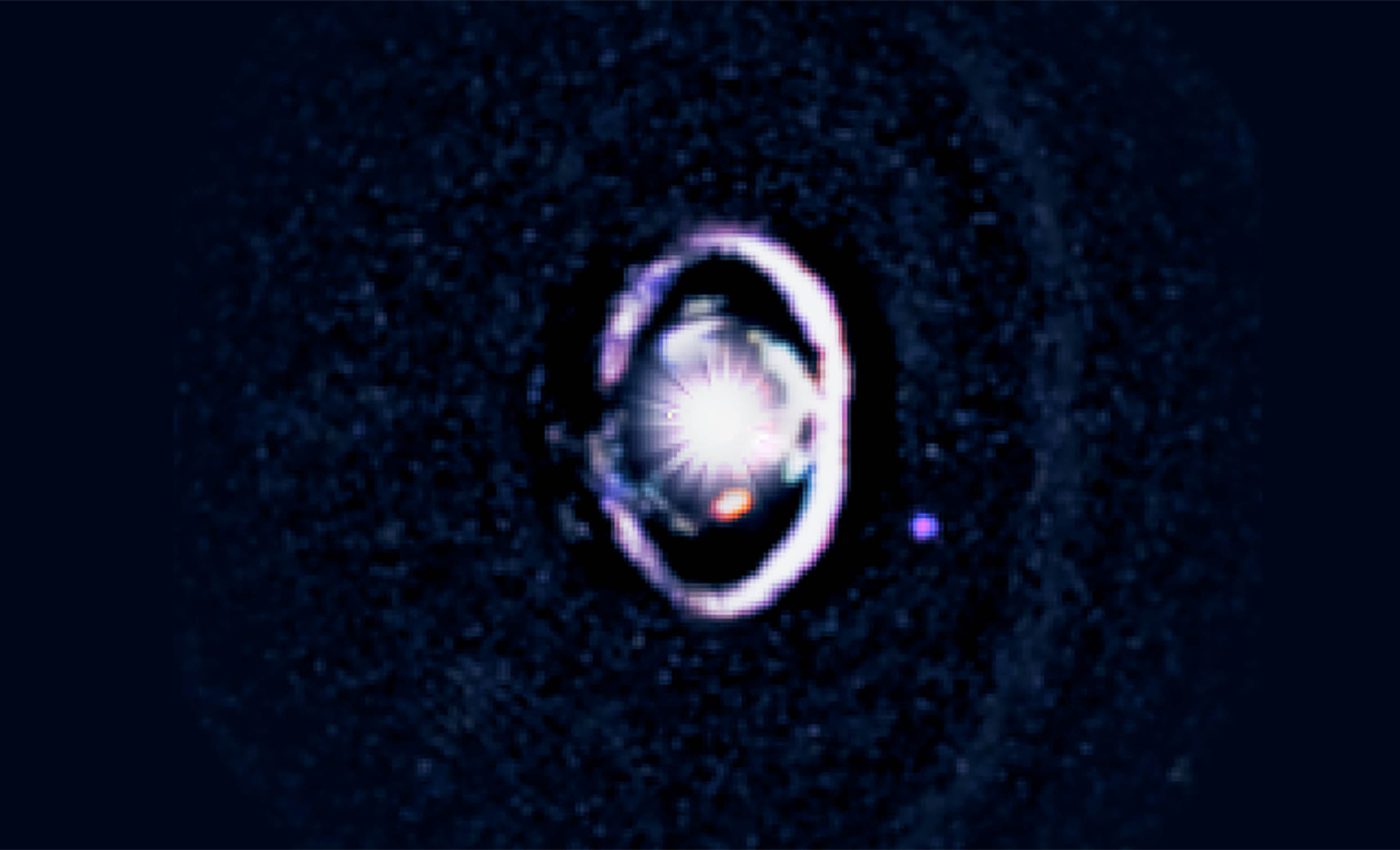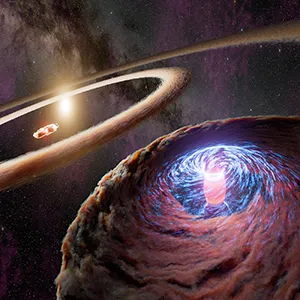
Baby planet photographed forming in a dust disk, while orbiting a star, for the first time ever
A team of astronomers has captured a young world, WISPIT 2b, sitting inside a dark ring around its star. The object is a protoplanet, a planet still forming inside a broad disk of gas and dust.
Instead of hiding in the central hole of the disk, WISPIT 2b shows up in a distinct ring gap, a quieter lane between two bright dust rings. That placement makes this detection unusual and scientifically valuable.
The research was led by Laird Close of the University of Arizona, using specialized optics and cameras.
How WISPIT 2b was found
The star, named WISPIT 2, hosts a multi-ring transitional disk that has bright bands separated by dimmer gaps. In one of those gaps, the team found a compact dot of light that lines up with where a growing planet should be.
The planet’s projected separation is about 54 astronomical units, which is roughly 5 billion miles from its star. At Earth’s distance scale, that is far beyond Neptune’s orbit.
H-alpha used to locate protoplanet
The researchers used H-alpha (Hα) light, a narrow shade of red emitted by hot hydrogen when gas falls onto a young object.
That glow is a clean tracer of accretion, the act of material landing on a planet and heating up enough to radiate.
“As planets form and grow, they suck in hydrogen gas from their surroundings. When the gas hits the surface of the protoplanet, it creates extremely hot plasma that in turn emits a particular light signature,” explained Laird Close.
The importance of gap planets
For years, models and observations have pointed to young planets as the culprits that sculpt rings and gaps in disks. Their gravity clears lanes, piles dust at the edges, and leaves the telltale architecture behind.
This picture was summarized in a broad review of transitional disks that laid out how planets can evacuate material and alter gas and dust patterns. Finding a planet directly in a ring gap puts a pin in that map.
Data reveals age and mass
The investigators report H-alpha detections on two nights with signal-to-noise ratios of 5.5 and 12.5, a measured separation near 309 milliarcseconds, and a position angle around 242 degrees.
The planet also shows up at longer infrared wavelengths, which helps constrain its thermal output.
With that data, the team estimates a mass of about 5.3 Jupiter masses and an age of roughly 5 million years.
The inferred accretion rate is roughly a few times 10 to the minus 12 solar masses per year, which fits expectations for a weakly accreting giant.
Telescopes measured planet’s brightness
Capturing such a dim signal next to a bright star required adaptive optics to sharpen the atmosphere’s blur and aggressive image processing to separate planet light from scattered starlight.
The MagAO-X instrument on the Magellan Clay Telescope in Chile (MCTC) was designed to work precisely at visible wavelengths where H-alpha sits.
The team also used the Large Binocular Telescope (LBT)’s infrared camera to measure the planet’s brightness in the L prime band.
That multi-color approach tightened the mass estimate and bolstered the case that the H-alpha dot is a real planet, not a dust knot.
WISPIT 2b compared to other planets
Before this discovery, the main example of a forming planet was one found in the system called PDS 70.
Astronomers first saw hydrogen light from a planet there in 2018, showing it was still growing. A second planet in the same system was confirmed the next year, also giving off the same light signal.
Those planets sit in the large central cavity of their disk. WISPIT 2b, by contrast, lies in a narrow ring gap between bright dust belts, so it probes a different neighborhood of planet building.

A possible second world
The data also reveal a fainter pointlike source closer to the star, tagged CC1 (Close Companion 1). Its location is about 110 milliarcseconds, or roughly 15 astronomical units, which comes to about 1.4 billion miles.
CC1 is red and bright at L prime yet shows little or no H-alpha, so it could be a warm object surrounded by a small circumplanetary disk or an unusually compact dust clump.
Follow-up spectra and orbital tracking will clarify whether it is another planet in the making.
Research to continue on WISPIT 2b
If WISPIT 2b cleared its lane, its gravity should push dust outward and inward, creating pressure bumps that trap particles. Measuring how sharply those edges rise can test how strongly the planet reshapes its environment.
Future observations could also time how the H-alpha signal changes. Variability can reveal whether the accretion flow comes in steady streams or sputters, a clue to how gas threads magnetic fields onto a young giant.
H-alpha is a reliable signpost
H-alpha targets hydrogen’s electron jump from the third to the second energy level. That transition is bright where gas is heated in shocks, like where infalling material meets a compact surface or inner disk.
Because that line sits at 656.3 nanometers, the glare from the star and the dusty disk must be suppressed extremely well.
Instruments that combine coronagraphs, ultra-stable optics, and fast wavefront control can isolate the planetary glow long enough to measure it.
What this means for planet formation
WISPIT 2b strengthens the idea that planets shape disks early, not just after they reach their final masses. Caught young, the planet is still hot and luminous, so its footprint on the disk is easier to trace.
Finding a planet in a ring gap also helps connect two pictures: the millimeter images that map dust and gas structure, and the optical and infrared detections that track embedded planets.
The more systems like this we collect, the clearer the formation story becomes.
WISPIT 2b and future study
A separation near 54 astronomical units translates to about 5.0 billion miles. The star itself is hundreds of light-years away, and one light year spans about 5.9 trillion miles.
Those scales make sense of why this work is hard. Even with a large telescope, the planet’s signal is a whisper next to a shout.
If CC1 proves to be a planet, the WISPIT 2 system will become a testbed for multiplanet interactions inside a still rich disk. Resonances between planets could stabilize orbits and stir ring edges in measurable ways.
Spectroscopy across visible and infrared bands can also separate planet light from heated dust. That split would refine the mass and age estimate and check whether a small disk around the planet adds extra infrared glow.
The study is published in The Astrophysical Journal Letters.
—–
Like what you read? Subscribe to our newsletter for engaging articles, exclusive content, and the latest updates.
Check us out on EarthSnap, a free app brought to you by Eric Ralls and Earth.com.
—–













